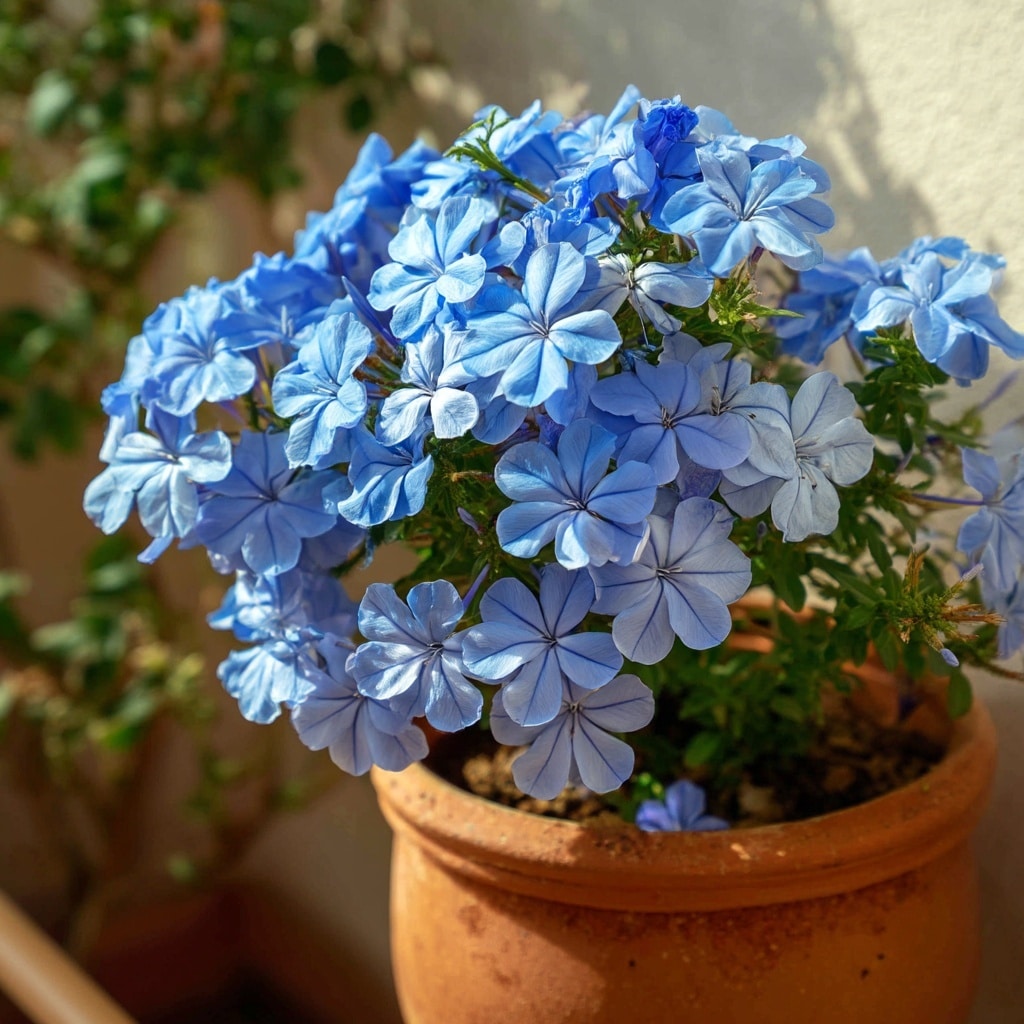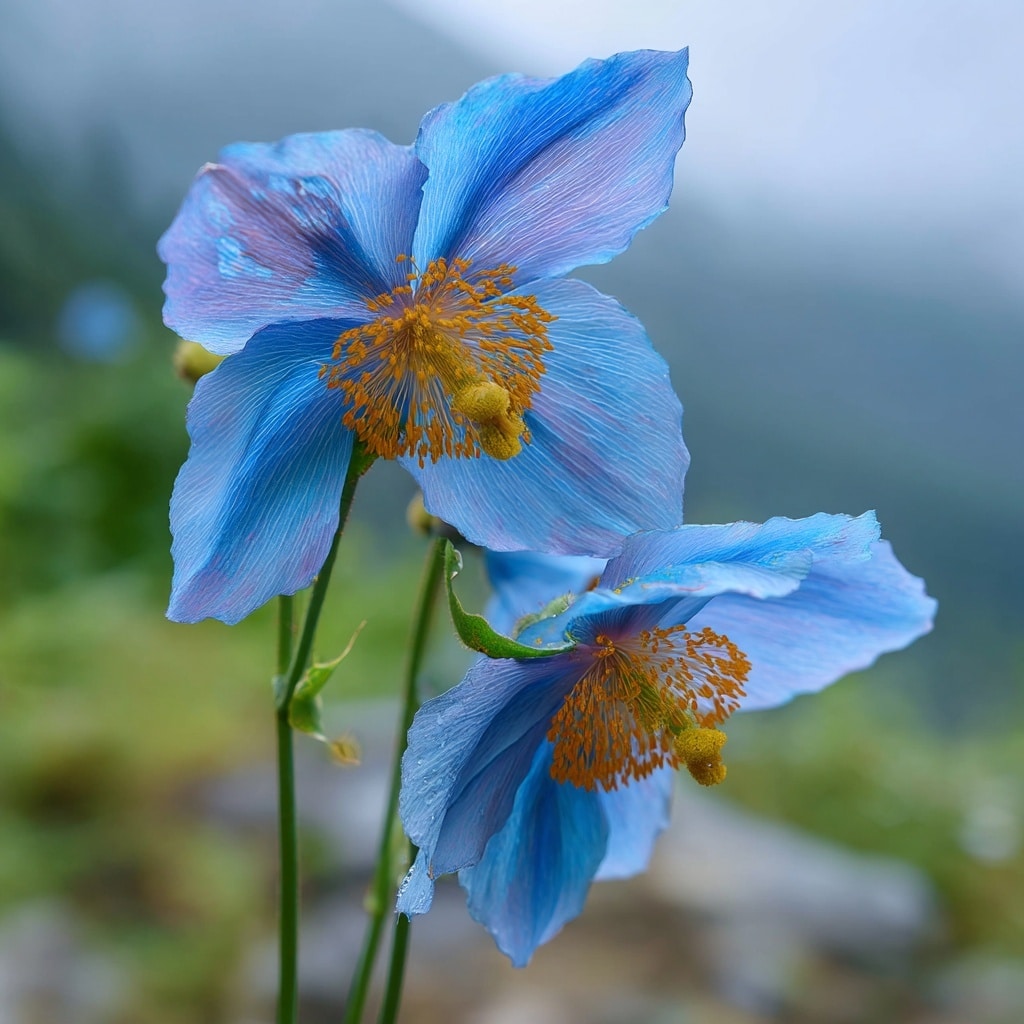Blue flowers bring a touch of cool serenity to any garden, whether you have a sprawling backyard or a modest balcony setup. While red, yellow, and orange blooms often steal the spotlight, blue remains a rare and enchanting hue in the floral world. Perhaps that’s what makes it so special — a calming visual escape from the heat and chaos of urban life. Despite their reputation for rarity, there are several easy-to-grow blue flowers that even beginner gardeners can successfully nurture. In this guide, we’ll introduce five beautiful options that can thrive in pots, beds, or trellises with just a little care.
Table of Contents
1. Aparajita (Clitoria ternatea)
If you’re looking for blue flowers that are both visually striking and incredibly easy to grow, the Aparajita is a top pick. Also known as the butterfly pea, this hardy creeper produces vivid blooms shaped like an inverted conch shell — a form that gives it the Sanskrit name Shankhpushp. It’s deeply rooted in Indian culture and spirituality, often associated with the goddess Devi, which adds symbolic richness to its natural beauty.
Aparajita comes in a range of shades including royal blue, sky blue, white, and light mauve. For balcony gardeners or those with vertical space, it’s a perfect fit. This vine thrives with basic care — just ensure it gets plenty of sunlight, regular watering, and occasional feeding with organic matter like cow dung or used tea leaves.
🧑🌾 Growing Tips:
- Sunlight: Full sun to partial shade
- Watering: Keep the soil moist but not soggy
- Soil: Well-draining, enriched with compost
- Maintenance: Regular deadheading encourages continuous blooming
- Dormancy: Prune hard in winter when it goes dormant
Once established, Aparajita will reward you with a steady flush of blue flowers from spring through autumn. It also has medicinal and culinary uses — the petals can be used for herbal tea or as a natural food colorant.
2. Morning Glory (Ipomoea purpurea)

Few plants offer the cheerful burst of color that blue flowers like Morning Glory bring to a garden wall, trellis, or railing. This fast-growing climber from the Ipomoea family is a morning delight — its trumpet-shaped blooms open with the sunrise and fade by afternoon, offering a fresh display every day during the blooming season.
The most captivating variety for blue lovers is Ipomoea purpurea, which showcases royal blue petals accented by white star-like veins. It’s a favorite among urban gardeners for its vigorous growth and ease of propagation. A handful of seeds is often all it takes to turn a dull fence into a flowering spectacle in just a few weeks.
🌱 Growing Tips:
- Sunlight: Requires full sun for best blooming
- Watering: Moderate; avoid overwatering as roots may rot
- Soil: Light, well-draining soil enriched with compost
- Season: Sow seeds between November and February (in tropical/subtropical climates)
- Maintenance: Deadhead spent blooms daily to extend flowering period
Morning Glory is not only one of the easiest blue flowers to grow from seed, but also a magnet for bees and butterflies. Just be sure to keep it in check — this enthusiastic creeper can take over quickly if left unmanaged!
3. Plumbago (Plumbago auriculata)

If you’re after a hardy shrub that delivers soft, sky-toned blue flowers in abundance, Plumbago is a must-have. Also known as Cape Leadwort, this South African native is perfect for warm climates and performs beautifully in both containers and garden beds.
Plumbago’s flower clusters resemble miniature hydrangeas — each bloom has five delicate petals marked by subtle blue veins. When grouped together, they create a cloud-like effect that softens the look of any space. It’s especially suited for border planting or cascading over walls, adding an elegant touch to balconies or garden edges.
☀️ Growing Tips:
- Sunlight: Full sun preferred; tolerates partial shade
- Watering: Moderate; allow topsoil to dry out slightly between waterings
- Soil: Well-draining with a neutral to slightly acidic pH
- Season: Blooms from spring through early autumn
- Maintenance: Minimal — prune lightly to maintain shape and remove spent blooms
Plumbago can handle heat well but may go semi-dormant during extremely hot summer months. Still, it remains one of the most dependable blue flowers for long-lasting color in your garden. Bonus: it’s relatively pest-resistant and attracts pollinators without demanding much in return.
4. Pansy (Viola × wittrockiana)

When winter sets in and most plants slow down, blue flowers like pansies come alive with color and charm. These cold-loving blooms are a staple in balcony planters and garden beds alike, known for their expressive “faces” and velvety petals. Though available in a wide palette, the blue and purple varieties remain a standout choice for gardeners seeking cool hues in the colder months.
Pansies are members of the violet family and are bred from a mix of species to achieve their wide-ranging colors and patterns. While they can be grown from seed, many gardeners prefer starting with nursery transplants to save time and ensure a lush winter display.
🌤️ Growing Tips:
- Sunlight: Full sun to partial shade in cooler months
- Watering: Keep soil evenly moist, but never soggy
- Soil: Rich, well-drained, slightly acidic soil
- Season: Plant in late autumn or early winter
- Maintenance: Regular deadheading promotes new blooms; fertilize lightly every few weeks
Despite their delicate appearance, pansies are surprisingly resilient and will reward you with months of blooming if cared for properly. They’re compact, colorful, and perfect for pots, railing planters, or garden edges — making them one of the most cheerful blue flowers for cooler climates.
5. Petunia (Petunia × hybrida)

If you want lush, cascading blue flowers that put on a continuous show from late winter through spring, petunias are a brilliant choice. These annuals are especially striking in hanging baskets, window boxes, and wide planters, where their trumpet-shaped blooms can spill over the edges in waves of color.
While petunias come in many shades and patterns, blue and violet varieties hold a unique appeal for gardeners looking to soften their space with cooler tones. Their lightly ruffled edges and velvety texture give them a soft, romantic look — perfect for patios or sunny balconies.
🌞 Growing Tips:
- Sunlight: Needs full sun (at least 5–6 hours daily)
- Watering: Water when the top inch of soil feels dry
- Soil: Loose, well-draining mix with good organic matter
- Season: Best planted in late winter or early spring
- Maintenance: Deadhead spent blooms to encourage continuous flowering; apply balanced liquid fertilizer every 2–3 weeks
When buying petunia seedlings, choose compact, bushy plants with plenty of unopened buds rather than full blooms — they’ll adjust better and bloom longer. With a little care, petunias will shower your space with vibrant blue flowers that bring elegance and joy all season long.
Honourable Mentions: Rare and Striking Blue Flowers
🌳 Jacaranda (Neel Mohar)

If you have room for a small tree in your yard or live in an area with wide streets and open plots, Jacaranda is a showstopper. Its lavender-blue blooms appear in clusters that nearly blanket the tree in color from April to June. Though technically a tree, its cool-toned flowers deserve a place in any blue flowers guide.
🧾 Quick Tip: Jacaranda prefers full sun and well-drained soil. Water sparingly — too much moisture encourages leaf growth over flowers.
Jarul (Giant Crape Myrtle)

Also known as Lagerstroemia speciosa or Pride of India, this tropical tree produces soft bluish-purple blooms that fade to pink as they mature. It’s heat-tolerant and flowers profusely during the warmer months, adding a majestic flair to parks and large gardens.
🧾 Quick Tip: Plant in full sun and prune in early spring to maintain structure and improve blooming.
Blue Hibiscus (Alyogyne huegelii & Hibiscus syriacus)

True blue hibiscus is rare, but some cultivars offer bluish-purple hues that come close. Alyogyne huegelii (Australian native) and Hibiscus syriacus (Rose of Sharon) are both options for those seeking a tropical-looking bloom with a cool twist.
🧾 Quick Tip: These shrubs thrive in full sun, alkaline soil, and benefit from regular pruning to encourage flowering.
Blue Water Lily (Nymphaea nouchali)

For gardeners looking to create a peaceful water feature, the blue water lily (also known as Neel Kamal) is an extraordinary option. Native to India, its luminous blue petals surround a glowing yellow center, creating a radiant floating bloom.
🧾 Quick Tip: Grow in shallow containers or tubs filled with heavy soil and topped with gravel. Avoid ponds if you have pets or small children.
Himalayan Blue Poppy (Meconopsis grandis)

Often considered the crown jewel of blue flowers, this ethereal poppy is native to the cool climates of the Himalayas. With its large, soft-blue petals and golden center, it’s breathtaking — but difficult to grow in warmer regions.
🧾 Quick Tip: Needs cold temperatures, constant moisture (but not soggy conditions), and rich organic soil. Ideal for gardeners in temperate or mountainous regions.
Conclusion
Adding blue flowers to your garden is more than a stylistic choice — it’s a way to create a calming, inviting space that stands out from the usual reds and yellows. Whether you’re working with a tiny balcony or a full backyard, there’s a blue bloom for every skill level and setup. From the ever-blooming Aparajita to the cascading beauty of Petunias, these plants bring a cool, soothing vibe all year round. Try mixing a few varieties together for layered color and texture — your garden (and your mood) will thank you.






